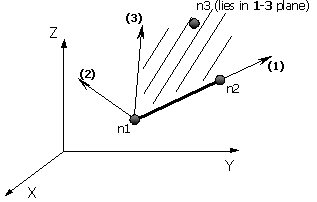Inelastic displacement-based frame element type - infrmDB
This is the displacement-based 3D beam-column element type capable of modelling members of space frames with geometric and material nonlinearities. As described in the Material inelasticity paragraph, the sectional stress-strain state is obtained through the integration of the nonlinear uniaxial material response of the individual fibres in which the section has been subdivided, fully accounting for the spread of inelasticity along the member length and across the section depth.
The displacement-based formulation follows a standard FE approach [e.g. Hellesland and Scordelis 1981; Mari and Scordelis 1984], where the element deformations are interpolated from an approximate displacement field, before the PVD is used to form the element equilibrium relationship. The DB formulation features two integration sections per element, and the Gauss quadrature is employed for higher accuracy.
In order to approximate nonlinear element response, constant axial deformation and linear curvature distribution are enforced along the element length, which is exact only for prismatic linear elastic elements. Consequently, infrmDB should be employed with members of small length, leading to the need for a mesh refinement, in order to achieve good accuracy in the case of higher order distributions of deformations. Typically, 4 to 6 elements per structural member need to be defined, hence users need to post-process nodal displacements/rotation in order to estimate the members chord-rotations [e.g. Mpampatsikos et al. 2008].
The number of section fibres used in equilibrium computations carried out at each of the element's integration sections needs to be defined. Users can click the View Discretization button in order to visualise the section triangulation (see figure below).

Further, multiple sections can be employed to define changes in reinforcement details between the two integration sections. Finally, the element-specific damping can also be defined by the Damping dialog box (users should refer here for a discussion on the different types of damping available and hints on which might the better options).
Note: If Rayleigh damping is defined at element level, using varied coefficients from one element to the other, or with respect to those employed in the global damping settings, then non-classical Rayleigh damping is being modelled, classing Rayleigh damping requires uniform damping definition.
Local Axes and Output Notation

